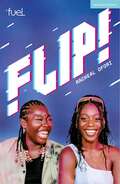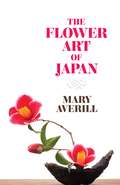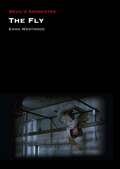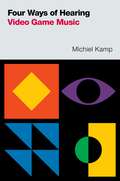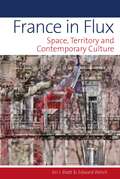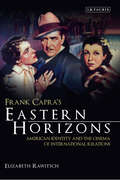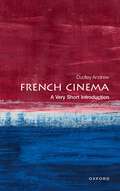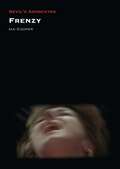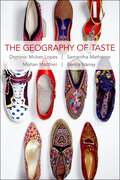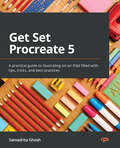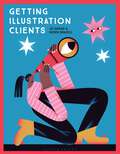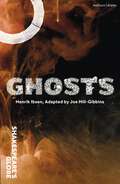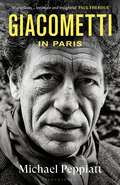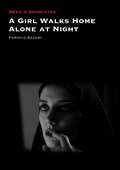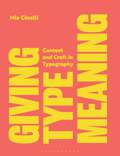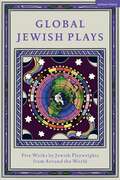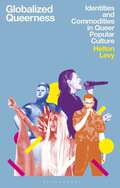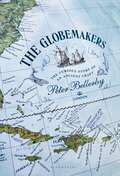- Table View
- List View
A Flight of Butterflies
by Kanzaka SekkaExquisite full-color plates depict 216 winged beauties, soaring and drifting across the pages in apparently seamless flight. Also includes a bonus CD-ROM that features all of the royalty-free butterfly graphics, both in full "flights" and separated into individual units. Ideal for lovers of fine art and for use by graphic artists, designers, and craftworkers.
FLIP! (Modern Plays)
by Racheal OforiCall my narcissism whatever you want. And while you're at it; like, comment, subscribe, worship - fucking bow down.Meet Carleen and Crystal. The influencers with cultural commentary that will have you in stitches! Love them or hate them, there's no stopping their fast-growing online following. Offline, Carleen has her reservations about their cyber personas, but she idolises Crystal and would follow her anywhere… even to FLIP!, the new social media giant that has everyone hooked – and Carleen and Crystal are no exception; especially when it seems that their videos could make them famous.Superstardom, followers, fame, influence, money: it's all just one click away. FLIP! is the answer to everything they've ever dreamed of. But is it too good to be true?FLIP! is a powerful new satire from critically-acclaimed writer Racheal Ofori that probes what it means to live freely under the shadow of social media, encroaching on every aspect of our lives. How can we be our authentic selves in a world of algorithms intent on proving just how disposable we all are? Originally produced by Fuel in association with Alphabetti Theatre and co-commissioned by Fuel and Soho Theatre, as part of Soho Six. This edition was published to coincide with the world premiere and UK tour starting in October 2023.
The Flower Art of Japan
by Mary AverillThis profusely illustrated book by an expert in the Japanese art of flower arrangement surveys many techniques, from ancient to modern. American writer Mary Averill (1866–1954) offers practical advice drawn from her direct experience of the importance of flowers to daily life in Japan. More than 80 drawings depict the finer details of choosing flowers, proper use of foliage, combining different varieties of flowers, and the symbolism involved. Averill, also known as Kwashinsai Kiyokumei, was proficient in the Japanese art of ikebana and the author of Japanese Flower Arrangement Applied to Western Needs. Averill embraced all the varied schools of Japanese flower arrangement, focusing on those producing the most attractive decorative effects and those exhibiting natural taste. She provides both novices and experienced flower arrangers with an informed and accessible guide to incorporating the beauty of this timeless art form into their everyday lives.
The Fly (Devil's Advocates)
by Emma WestwoodIt's not often that a remake outshines its original but David Cronenberg's "reimagining" of The Fly (1986) is one of those rare exceptions. Equal parts horror, science fiction, and romance, The Fly takes the premise of its 1958 original—a man unintentionally fusing with a housefly during an experiment in teleportation—and reinterprets the plot as a gradual cellular metamorphosis between these two organisms.This book teases out the intricate DNA of The Fly and how it represents the personalities of many authors, including a distinguished history of Man-as-God tales stretching back to Mary Shelley's Frankenstein (1818). Drawing from interviews with cast, crew, film commentators, and other filmmakers, Emma Westwood interlaces the "making of" travails of The Fly with why it is one of the most important examples of master storytelling ever committed to screen.
For Black Boys Who Have Considered Suicide When The Hue Gets Too Heavy (Modern Plays)
by Ryan Calais CameronNominated for Best New Play at the 2023 Olivier AwardsI found a king in me and now I love youI found a king in you and now I love meFather figures and fashion tips. Lost loves and jollof rice. African empires and illicit sex. Good days and bad days. Six young Black men meet for group therapy, and let their hearts - and imaginations - run wild.Inspired by Ntozake Shange's essential work For Colored Girls Who Have Considered Suicide / When the Rainbow is Enuf, For Black Boys Who Have Considered Suicide When The Hue Gets Too Heavy is a profound and playful work, co-commissioned by Boundless Theatre, from multi-award-winning company Nouveau Riche and playwright Ryan Calais Cameron.For Black Boys... gained critical acclaim for the world premiere in October 2021 at New Diorama Theatre, before successfully transferring to London's Royal Court Theatre in March 2022. This edition was published to coincide with the second West End production at the Garrick Theatre in March 2024.
Four Ways of Hearing Video Game Music (Oxford Music / Media)
by Michiel KampFour Ways of Hearing Video Game Music offers a novel account of the ways in which video games invite us to hear and listen to their music. By taking a phenomenological approach to characterize music in video games, author Michiel Kamp asks what it is we hear in the music when we play a game. Drawing on past phenomenological approaches to music as well as studies of music listening in a variety of disciplines such as aesthetics and ecological psychology, Kamp explains four main ways of hearing the same piece of music--through background, aesthetic, ludic, and semiotic hearing. As a background, music is not attended to at all, but can still be described in terms of moods, affordances, or equipment. Aesthetic hearing is a reflective attitude that invites hermeneutic interpretation; ludic hearing on the other hand invites "playing along" to the music, either through embodied movement, or in response to the music's cinematic or theatrical connotations. Finally, in semiotic hearing, Kamp argues that we hear music as transparent symbols or signals that provide information about the state of a game. The book investigates these four categories through detailed case studies of video games from a variety of eras and genres accompanied by gameplay recordings and images on a companion website.
France in Flux: Space, Territory and Contemporary Culture (Contemporary French and Francophone Cultures #59)
The look and feel of metropolitan France has been a notable preoccupation of French literary and visual culture since the 1980s. Numerous writers, filmmakers and photographers have been drawn to articulate France’s contrasting spatial qualities, from infrastructural installations such as roads, rail lines and ports, to peri-urban residential developments and isolated rural enclaves. In doing so, they explore how the country’s acute sense of national identity has been both asserted and challenged in topographic terms. This wide-ranging collection of essays explores how the contemporary concern with space in France has taken shape across a range of media, from recent cinema, documentary filmmaking and photographic projects through to television drama and contemporary fiction, and examines what it reveals about the state of the nation in a post-colonial and post-industrial age. The impact of global flows of capital, trade and migration can be mapped through attention to the specificities of place and topography. Investigation of liminal locations, from seaboard cities and abandoned industrial sites to refugee camps and peasant smallholdings, interrogates the assertion of a national territory (and, by extension, a national identity) through the figure of the hexagon, and highlights the fluidities, instabilities and lines of flight which render it increasingly unsettled.
France’s Memorial Landscape: Views from Camp des Milles (Contemporary French and Francophone Cultures #91)
by Sophie FuggleDuring August 1942 several women jumped to their deaths from a second story window at the tile factory in the small town of Milles near Aix-en-Provence. Between 1939 and 1942 the factory assumed various roles as internment camp, transit camp and ultimately deportation camp. This book is about the view from the ‘suicide window’ as it is presented within the Camp des Milles memorial museum which opened in 2012. It explores how this view might help us to understand and imagine the world of internment and deportation camps operating in France during the Second World War and their memorial today. The book uses the views framed by the window to think critically about the museography of the memorial within the wider context of France’s relatively late acknowledgment of its role in the persecution of the Jews during the Second World War.
Frank Capra's Eastern Horizons: American Identity and the Cinema of International Relations (Cinema and Society)
by Elizabeth RawitschFrank Capra has long had a reputation as being the quintessential American director - the man who perfectly captured the identity and core values of the United States with a string of classic films in the 1930s and '40s, including It Happened One Night, Mr. Smith Goes to Washington and It's a Wonderful Life. However, as Elizabeth Rawitsch argues, Capra's construction of national identity did not occur within an exclusively national context. She points out that many of his films are actually set in, or include sequences set in, China, Latin America, the Philippines and the South Seas. Featuring in-depth textual analysis supported by original archival research, Frank Capra's Eastern Horizons explains that Capra's view of what constituted 'America' changed over time, extending its boundaries to embrace countries often far from the United States.Complicating Edward Said's theory of Orientalism as a strict binary in which the West constructs the East as an inferior 'other', it demonstrates that East and West often intermingle in films such as The Bitter Tea of General Yen and in Capra's orientation documentaries for World War II American servicemen; Capra imagined a kind of global community, albeit one with heavy undertones of British and American imperialism. Investigating shifts in what Capra's America has meant over time, both to Capra and to those who have watched and studied his films, this innovative book offers a startlingly fresh perspective on one of the most iconic figures in American film history.
French Cinema: A Very Short Introduction (Very Short Introductions)
by Dudley AndrewIt is often claimed that the French invented cinema. Dominating the production and distribution of cinema until World War 1, when they were supplanted by Hollywood, the French cinema industry encompassed all genres, from popular entertainment to avant-garde practice. The French invented the "auteur" and the "ciné-club"; they incubated criticism from the 1920s to our own day that is unrivalled; and they boast more film journals, fan magazines, TV shows, and festivals devoted to film than anywhere else. This Very Short Introduction opens up French cinema through focusing on some of its most notable works, using the lens of the New Wave decade (1958-1968) that changed cinema worldwide. Exploring the entire French cinematic oeuvre, Dudley Andrew teases out distinguishing themes, tendencies, and lineages, to bring what is most crucial about French Cinema into alignment. He discusses how style has shaped the look of female stars and film form alike, analysing the "made up" aesthetic of many films, and the paradoxical penchant for French cinema to cruelly unmask surface beauty in quests for authenticity. Discussing how French cinema as a whole pits strong-willed characters against auteurs with high-minded ideas of film art, funded by French cinema's close rapport to literature, painting, and music, Dudley considers how the New Wave emerged from these struggles, becoming an emblem of ambition for cinema that persists today. He goes on to show how the values promulgated by the New Wave directors brought the three decades that preceded it into focus, and explores the deep resonance of those values today, fifty years later. ABOUT THE SERIES: The Very Short Introductions series from Oxford University Press contains hundreds of titles in almost every subject area. These pocket-sized books are the perfect way to get ahead in a new subject quickly. Our expert authors combine facts, analysis, perspective, new ideas, and enthusiasm to make interesting and challenging topics highly readable.
Frenzy (Devil's Advocates)
by Ian CooperFrenzy (1972) was Alfred Hitchcock's penultimate film, and arguably one of his most misunderstood and neglected. Whereas even Psycho (1960) did eventually become respectable – indeed, it's a good contender for the most admired of the Master's films - Frenzy still remains problematic for many. While Raymond De Foery makes his feelings clear in the title of his book, Alfred Hitchcock's Frenzy: The Last Masterpiece, Hitchcock's controversial biographer Donald Spoto calls the film "repulsive" and "a closed and coldly negative vision of human possibility". Frenzy is perhaps Hitchcock's most nakedly autobiographical film, representing both a comeback and farewell to the city of his birth. But it started out as a very different kind of project. This Devil's Advocate discusses the evolution of the film, its production, reception, and place in Hitchcock's oeuvre, as well as its status as a key film of "sleazy Seventies" British cinema.
From Wheel House to Counting House: Essays in Maritime Business History in Honour of Professor Peter Neville Davies (Research in Maritime History #2)
by Lewis R. FischerThis volume is dedicated to Maritime Business History, by means of commemorating the career of Professor Peter Neville Davies, a prominent member of the Economic and Social History department of the University of Liverpool (a career spanning the dates 1964-1992). The volume is divided into four sections. The first is a tribute and appreciation of Professor Davies, which also acts as an introduction to his work for unfamiliar readers. The second section focuses on business aspects of British maritime history, with particular attention to the impact of British shipping overseas, and the rise and decline of shipbuilding industries. The third section is specific to Liverpool and Merseyside, and explores the local maritime history of the area, including trade with the Mediterranean, local shipbuilding, the Mersey port system, and nautical archaeology. The final section explores subjects within international maritime history, particularly within Norway and America. All essays and topics covered aim to collectively and significantly develop the field of maritime business history, and all are directly related to Professor Davies’ academic interests, as a means of celebrating Professor Davies own accomplishments during his career. The journal concludes with a comprehensive bibliography of Professor Davies’ work.
Gay Conversion Practices in Memoir, Film and Fiction: Stories of Repentance and Defiance (Library of Gender and Popular Culture)
For over half a century, organizations and individuals promoting ex-gay, conversion and/ or reparative therapy have pushed the tenet that a person may be able to, and should, alter their sexual orientation. Their so-called treatments or therapies have taken various forms over the decades, ranging from medical (including psychiatric or psychological) rehabilitation approaches, to counselling, and religious healing. Gay Conversion Practices in Memoir, Film and Fiction provides an in-depth exploration of the disturbing phenomenon of gay conversion 'therapy' and its fictional and autobiographical representations across a broad range of films and books such as But I'm a Cheerleader! (1999), This is What Love in Action Looks Like (2011) and Boy Erased (2018). In doing so, the volume emphasizes the powerful role the arts and media play in communicating stories around conversion practices. Approaching the timely and urgent subject from an interdisciplinary perspective, contributors utilize film theory, queer theory, literary theory, mental health and social movement theory to discuss the medicalization and pathologizing of queer people, the power of institutions ranging from church, psychiatry and family (sometimes in alliance), and the real and fictional voices of survivors.
The Gentleman Dancing-Master: Mr Isaac and the English Royal Court from Charles II to Queen Anne (Clemson University Press: Studies in British Musical Cultures)
by Jennifer ThorpThe Gentleman Dancing-Master: Mr Isaac and the English Royal Court from Charles II to Queen Anne is a study of the life of the most significant dancing-master at the late-Stuart court in London. It discusses his use of dance music and brings together, for the first time, reprints of the notations of all his twenty-three surviving dances created for performance at court in the presence of the monarch, including several created to celebrate the birthdays of Queen Anne or named after important courtiers or political events. This study highlights the significance of dance as a central part of court culture, and also the wider context of the London book trade within which Isaac’s notators turned his dances into a publishable form ultimately taken over by John Walsh’s music publishing firm. Using extensive archival and printed sources from his day, the book follows Isaac’s career as a dancer, teacher, and choreographer of sophisticated duets in the fashionable French style, some of which were also performed in the theatre. Isaac, however, was no slavish follower of French fashion, and by careful consideration of the extant dances from the point of view of a dancer, this study also seeks to throw light on Isaac’s often individualistic approach to choreography.
The Geography of Taste (Thinking Art)
by Bence Nanay Dominic McIver Lopes Samantha Matherne Mohan MatthenThis is an open access title available under the terms of a CC BY-NC-ND 4.0 license. It is free to read at Oxford Academic and offered as a free PDF download from OUP and selected open access locations. Wherever on the globe anyone sets foot, they find people immersed in matters aesthetic. In UNESCO's definition, there can be no culture that lacks an aesthetic life. Aesthetic life is in this sense a cultural universal. At the same time, aesthetic engagement has a geography. While all cultures have an aesthetic, no single aesthetic belongs to all cultures. The rules of aesthetic engagement vary by culture. How should aesthetics proceed if we take this fact of aesthetic diversity, rather than the presumption of aesthetic universality as our starting point? How should we theorize the cultural origins and cultural basis of aesthetic diversity? How should we think about the value and normativity of aesthetic diversity? To model what the turn toward diversity might look like in aesthetic inquiry, the four authors of this book each defend a different account of aesthetic diversity, and together they engage in a collective dialogue about these issues. The Geography of Taste will interest students in aesthetics courses as well as others interested in novel, global approaches to aesthetics.
Get Set Procreate 5: Tips, Tricks, And Best Practices For Illustrating On An Ipad
by Samadrita GhoshGetting Illustration Clients
by Professor Jo Davies Derek BrazellThe commissioning process can be a confusing maze for the commercial illustrator just starting out – so let Getting Illustration Clients be your beacon for success. Written by the duo that brought you Becoming a Successful Illustrator, here Jo Davies and Derek Brazell demystify the commissioning process for commercial illustration, from the point of the view of those hiring and briefing freelance illustrators: the art editors, the designers, the agents and more. With insider tips that will make your work garner attention and satisfy the needs of the brief, each section is beautifully illustrated with full-colour examples of projects typical to main areas of practice from around the globe. Organised with key action points and summaries, as well as case studies from commissioning professionals for Harper Collins, VMLR&Y Wooga Games, and many more. Supporting exercises support Jo and Derek's guidance, to be used off the shelf by students, graduates and early-career professionals working independently. For the practicing illustrator, who want to see the commissioning process from 'the other side', you will always have to hand expert advice on what clients want, how commissioning works and how to get your work noticed. For lecturers in illustration, this is your go-to recommend for recent graduates looking for advice on the working world of commercial illustration.
Ghosts (Modern Plays)
by Henrik IbsenThere are ghosts everywhere. There are ghosts here right now.Plagued by the ugly truth of her late husband's legacy, Helene vows to erase the past and start again.Ignorant to the reality of his father's character, Osvald, her son, returns home to face an uncertain future. But when the ember of an illicit romance stands to ruin Helene's plans to play happy family, she is forced to make a decision that threatens to engulf what's left of her – and her son's – life completely.Experience the work of Henrik Ibsen, one of the most influential dramatists of all time, in a scandalous and searing exploration of family secrets and forbidden desire. Nearly 150 years after causing a furore when it premiered with its depiction of incest, infection and euthanasia, adaptor and director Joe Hill-Gibbins (The Marriage of Figaro, ENO; The Tragedy of King Richard The Second, Almeida), in his Globe debut, brings a new version of Ghosts, the first modern tragedy, to the Sam Wanamaker Playhouse.Ghosts was part of the Sam Wanamaker Playhouse 10th Anniversary Season. This edition was published to coincide with the world premiere at The Globe's Sam Wanamaker Playhouse in November 2023.
Giacometti in Paris
by Michael Peppiatt'Marvellous . . . intimate and insightful . . . reads like a novel by Samuel Beckett' Paul Theroux A portrait of one of the twentieth century's greatest sculptors from one of our most eminent art historiansToday the work of Alberto Giacometti is world-famous and his sculptures sell for record-breaking prices. But from his early days as an unknown outsider to the end of a dramatic international career, Giacometti lived in the same hovel of a studio in Paris. It was Paris that made him, and he in turn immortalised the city through his art.Arriving in Paris from the Swiss Alps in 1922, Giacometti was shaped not only by his relationships with remarkable artists and writers – from Picasso, Breton and Dalí to Sartre, Beauvoir and Beckett – but by the everyday life, pre-war and post-war, of Paris itself. His distinctive figures emerged from the city's unique atmosphere: the crumbling grey stone of its humbler streets and the café-terraces buzzing with radical ideas and racy gossip.In Giacometti in Paris, Michael Peppiatt, who spent thirty years documenting the Parisian art world and mixing with many of the people Giacometti knew, brilliantly charts the course of the artist's life and work. From falling in and out with the Surrealists to years of artistic anguish, from devotion to his mother to intense friendships, tragic love affairs and a fraught marriage, this is an intimate portrait of an outstanding artist in exceptional times.
A Girl Walks Home Alone at Night (Devil's Advocates)
by Farshid KazemiThere is something weird and eerie going on in the oneiric Iranian ghost-town Bad City. A mysterious female vampire, clad in a long-black veil, imbued with occult and erotic power, has newly arrived in town and is summarily dispensing with its unsavory characters. Through a chance encounter in a night of luminal darkness, an eternally dark romance begins – baptized in love’s blood. Shot in dazzling anamorphic black and white cinematography and accompanied with an intoxicating and mesmeric soundtrack, Ana Lily Amirpour’s debut feature film A Girl Walks Home Alone At Night (2014), was an instant popular and critical success. Dubbed ‘the first Iranian vampire western’ the genre-bending film is a pastiche of genres such as vampire cinema, gothic and horror films, spaghetti westerns, graphic novels, and Iranian cinema; yet the film stands as a new vampire fairy-tale with a unique style all its own. The first full-length study dedicated to the film since its release, this book in the Devil’s Advocate series provides a unique approach to the film situated within three theoretical coordinates: the vampire genre, psychoanalytic (film) theory and German Idealism.
Giving Type Meaning: Context and Craft in Typography
by Mia CinelliWhen we encounter typography, how do we know what it means? How is the tone of type influenced by the way it is set, when it is made, and where it exists? Considering the social, spatial, and temporal contexts of visual language, this text informs and inspires students, educators, and professionals looking to engage more deeply with the letterforms they use and see. Featuring diverse typographic works, “closer looks”, and interviews with practicing artists and designers, Giving Type Meaning serves to inform how and why we understand what type communicates. The book includes: - The importance and impact of cultural and social context across the expanded field of art and design- How to use visual, physical, and gestural space to inform meaning- The ways time impacts type, such as historical references, recontextualizations, and the use of time as medium - A range of global examples, including Lushootseed language letterforms (Lushootseed Sulad by Juliet Shen), Arabic calligraphy and type design (Regard Each Other as Brothers by Josh Berer, Mirsaal by Rana Abou Rjeily), American civil rights inspired type (Martin by Tré Seals), Italian concrete poetry (Storia Del Monumento by Mirella Bentivoglio), and animated Chinese characters (Motion Type Project by Ting-An Ho)
Global Jewish Plays: Extinct; Heartlines; The Kahena Berber Queen; Papa’gina; A People (Methuen Drama Play Collections)
by Berthe Bénichou-Aboulker Hana Vazana Grunwald Sarah Waisvisz Philip Arditti L M FeldmanA unique collection of plays that brings together stories of Jewish life from playwrights around the world. Curated and edited by an international theatre collective, these five plays showcase the dazzling multiplicity of Jewish narratives across the globe: the haunting, the challenging, the joyful. From a legendary North African warrior queen to queer French avant-garde artists during World War II; from Israel-Palestine tensions made personal to protests in Istanbul amidst intergenerational trauma, this is a genre-spanning collection that probes at the heart of what it means to be Jewish - past, present, and future. Curated by Jewish-Lebanese Brazilian queer theatre maker, the plays were performed at London's Bush Theatre as part of Global Voices Theatre's popular live events. At a sensitive time for Jewish communities in the UK and beyond, the original event Global Jewish Voices aimed to engage the UK Jewish community and make space for nuanced conversations and representation. This collection of selected plays is a legacy of the event and opens up avenues for wider audiences to read and perform the works.
Globalized Queerness: Identities and Commodities in Queer Popular Culture (Library of Gender and Popular Culture)
by Helton LevyHas a global queer popular culture emerged at the expense of local queer artists? In this book, Helton Levy argues that global queer culture is indebted to specific, local references that artists carry from their early experiences in life, which then become homogenized by contemporary media markets. The assumption that queer publics live and consume only through a global set of references, including gay parades and rainbow flags, for example, erases many personal complexities.Levy revisits media characters that have caught the attention of the broader public – such as Calamity Jane (1953), the Daffyd Thomas character from the BBC comedy Little Britain (2003-2007), Brazilian drag queen Pabblo Vittar, French singer Christine and the Queens, and the Italian-Egyptian rapper Mahmood – and argues that they have gradually blended in the public's perception. This has often obscured the individual struggles faced by these characters, such as immigration, homophobia, poverty and societal exclusion. Levy also questions what happens when global media flows take queer culture to regions wherein the notion of LGBTQ+ rights are not entirely acceptable. Utilizing insights from media reports published across the world's ten biggest media markets, Levy argues that there are a series of conditions which artists and cultural actors negotiate once they achieve any kind of success in mainstream media, while local queer references remain unseen in the wider media world. For that reason, he argues for stronger incentives for communities to accept and acknowledge the work of queer people before and after commoditization.
The Globemakers: The Curious Story of an Ancient Craft
by Peter BellerbyThe beautiful illustrated story of our globe and the creations it has inspired, told by the only truly bespoke globemakers in the world, Bellerby & Co. Globemakers'The untold story of the globe, this book is a glorious spyhole into a forgotten art' - Lara Maiklem, author of Mudlarking Peter Bellerby is the founder of Bellerby & Co. Globemakers, the world's only truly bespoke makers of globes. His team of skilled craftspeople make exquisite terrestrial, celestial and planetary globes for customers around the world. The story began after his attempt to find a special globe for his father's 80th birthday. Failing to find anything suitable, he decided to make one himself which took him on an extraordinary journey of rediscovering this forgotten craft.The chapters of The Globemakers take us through the journey of how to build a globe, or 'earth apples' as they were first known, and include fascinating vignettes on history, art history, astronomy and physics, as well as the day-to-day craftsmanship at the workshop itself.This beautiful book uses illustration, photography and narrative to tell the story of our globe and many different globes it has inspired.---------'A book as beautiful as the craft it describes, The Globemakers is an inspirational story of a craftsman's dogged pursuit for perfection. It's written with the intricacy of someone who can capture the fine details of our vast planet in something small enough to sit on your desk' - Rebecca Struthers, author of The Hands of Time'Absolutely fascinating from beginning to end - an adventure like no other!' - Alice Loxton
Golden Gate Bridge, USA (Large Print)
This image shows the 2.7 kilometre long Golden Gate suspension bridge. It spans the width of the page and is bounded by a dashed line image border. There is a locator dot shown, which will be at the top left of the page when the image is the right way up. Along the bottom of the image is the water. Just up from this on the left side of the page is a small piece of land and one end of the bridge's roadway. Right from this is a small arch reaching up from the water then a tall tower supporting the main suspension cables, which curve down and rise up again to another tall tower on the right of the page. The roadway is suspended from vertical cables attached to the main cables and continues to another piece of land on the right of the page.

